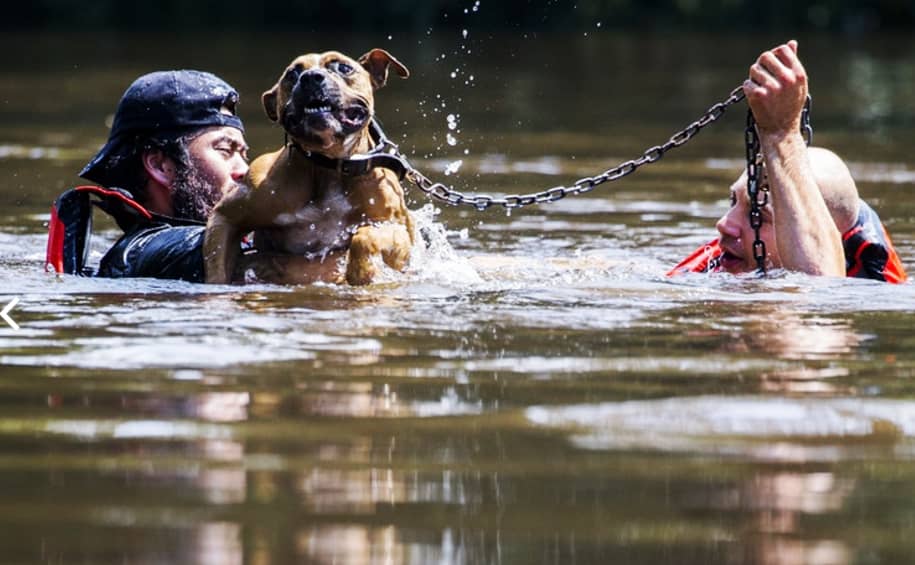
Save dogs from drowning. Have your say on proposed regulations.
The Ministry for Primary Industries is now seeking public feedback on proposed regulations on the chaining of dogs.
In short, I ask that you make a submission and plea that any animal should not be tethered where it is at risk of harm from extreme weather or an emergency. There are many other very valid reasons why dog chaining has negative animal welfare outcomes, but there are many good organisations such as SAFE that are lobbying change on those grounds. My focus is around animal disaster law and how we can improve our tarnished international animal welfare reputation. Learn more about the proposed regulations here.
With recent flood events smashing New Zealand, animals too have been affected. Simply put, chained animals are unable to defend themselves from flooding and the human decision to restrain them contributes to making them highly vulnerable to such hazards and drowning. Disasters are not natural, they are an event process that is caused by human decisions.

Texas learned the hard way, but were brave enough to pass specific law that made it an offence to tether a dog where it may be at risk from extreme weather events. This best practice law, was then adopted by Kapiti Coast District Council following a submission by Animal Evac New Zealand to their review of dog control bylaws and they became the first territorial local authority to pass an animal disaster management bylaw (under the Kapiti Coast District Council Dog Control Bylaw) in 2019.
Clause 7.1 (e): “Measures must be taken to enable dogs to keep warm in cold weather, cool in warm weather, and safe in extreme weather or during a civil defence emergency”
More recently, Texas passed the Safe Outdoor Dog Act leading to stricter controls around tethering of dogs and harsher penalties.
In 2005, America was struck by Hurricane Katrina. The deadliest natural disaster in their history at that time. Over 1,800 people died in that disaster, millions of animals also perished. 44% of those who failed to evacuate did so in part because they could not take their pets. At the time, government policy was to leave pets behind. Within a year of this tragedy, the US government realising the intrinsic link between people and animals, passed the Pets Emergency & Transportation Standards Act 2006.
New Zealand has made little effort to learn from the grave mistakes of the USA. The US government mandated funding, planning and capability for animal disaster management. By contrast, New Zealand still does not mandate responsibility for animal emergency management plans, fails to provide for the reimbursement of response costs incurred by animal charities, and laws continue to fail to sufficiently recognise animals require protection in disasters. In 2010, I completed my Masters in Emergency Management and made recommendations to government including MPI and the Ministry of Civil Defence & Emergency Management (now NEMA), noting significant deficiencies in our arrangements to protect animals from disaster. None of the 60 recommendations have been implemented. Even a submission I wrote in 2017, as CEO of Wellington SPCA on the Ministerial Review on Civil Defence, failed to create change despite a notable percentage of public submissions supporting the call for improved animal disaster law and arrangements.
Seven years later, the Edgecumbe Floods struck and over 1,000 animals were left behind in the town and the fire service wouldn’t go back in because there were no people left in the town. Many animals died needlessly. If it wasn’t for the massive efforts by the animal rescue volunteers, more would have died. One story was that of a woman who wanted to return to rescue her horse was refused entry at the cordon. As a result, she swam across the flooded Rangitāiki river with some ropes to rescue her horses. Simply put, saving animals in disasters saves human lives. Indeed, leading scholars in this area have stated “Pet ownership is the single most common factor associated with human evacuation failure that can be positively affected when the threat of disaster is imminent”. Studies have also found that the phycological impact of pet loss can be just as traumatic as losing one’s home or even another family member.
As the US passes yet another federal law to improve animal welfare in disasters through the passage of the Planning for Animal Wellbeing (PAW) Act, mandating FEMA (the US NEMA equivalent) to lead improvements across a number of areas, New Zealand has not even made any effort to introduce basic animal disaster laws despite in 2019, a report being presented by Gareth Hughes MP and the Craig Fugate the former Administrator of FEMA during the post-Hurricane Katrina reform period. The Director of Civil Defence at the time noted the report as a “worthy piece of work that raises a number of important matters for consideration” and “matters raised in the report specific to this regulation (National CDEM Plan) will be considered in the scope of the review”.
New Zealand is failing animals and is no longer world leader in animal welfare.
It is unusual, that a dog specific regulation is being proposed under the Animal Welfare Act, and not the Dog Control Act 1996. By doing so, it will place further demand on charities like the SPCA to enforce the laws of parliament despite dog control being funded as a core function of council through dog control registration fees. There is little point introducing another law, where the compliance function is not sufficiently resourced for existing provisions.
If the proposed regulation is to sit under the Animal Welfare Act 1999, then it should not be species specific – any chained sentient animal is at equal risk and should be afforded the same statutory protection. If the regulation is to be dog specific, then a clause should be made that makes it also an offence under the Dog Control Act 1996 to allow for enforcement by local government animal control. This would also mean that Kapiti Coast District Council would not have to be lone champion in this space, trying to address the issue with a limited sanction. Such legal provisions are already used such as making certain offences under the Dog Control Act 1999 an offence under the Animal Welfare Act 1990 (section 174) and regulations can also be made under the Dog Control Act 1996 to create a mirrored statutory instrument to ensure regulatory compliance can be undertaken by local authorities.
We need changes to introduce animal disaster law in New Zealand. The proposed regulations are a good opportunity to start making improvements in this space.
I encourage you to make a submission to MPI on the proposed regulations, recommending:
Email your feedback on the proposals by 5pm on 15 March, 2023 to animal.consult@mpi.govt.nz. You are welcome to cut and paste the above if it helps.